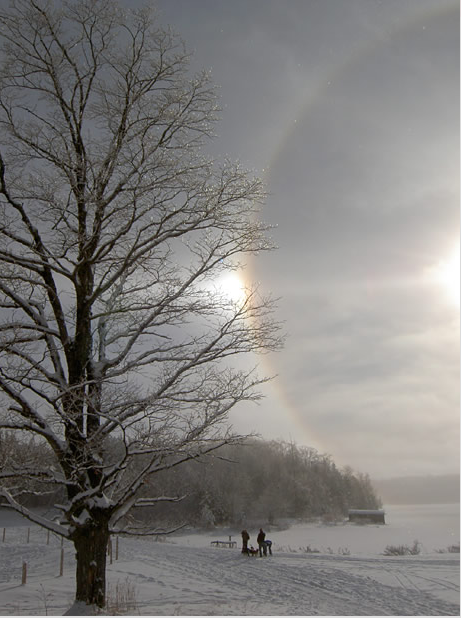Halo Display Collingwood, Ontario, Canada
Halo Display Collingwood, Ontario, Canada: A Winter Wonderland of Atmospheric Optics
Collingwood, Ontario, Canada is not only known for its picturesque winter landscapes but also for its stunning atmospheric optical displays. One such phenomenon that graces the skies of Collingwood is the Halo Display. This natural spectacle mesmerizes both locals and visitors alike, offering a captivating glimpse into the wonders of light and ice crystals interacting in the atmosphere.
The Parhelic Circle and the 22° Halo
In a captivating photograph taken by Angel Langmuir in December '05, we are treated to an idyllic winter scene in Collingwood, Ontario. The image beautifully showcases the parhelic circle, which appears as a complete circle passing through the sun, inside the 22° halo. The parhelic circle near the sun is primarily formed by light reflecting externally from the near-vertical faces of plate and sometimes column crystals. This interaction between sunlight and ice crystals creates a mesmerizing display that enchants viewers.
The Science Behind the Halo Display
To truly appreciate the beauty of the Halo Display in Collingwood, it's essential to understand the science behind it. Halos are optical phenomena that occur when light interacts with ice crystals suspended in the atmosphere. In the case of the 22° halo, which is the most commonly observed halo, hexagonal ice crystals play a crucial role.
When sunlight passes through these ice crystals, it undergoes refraction, bending the light at specific angles. This bending causes the light to form a circle with a radius of approximately 22 degrees around the sun. The parhelic circle, on the other hand, is formed by light reflecting off the crystal faces at specific angles. These interactions create a mesmerizing display of halos and circles in the sky.
Unique Atmospheric Conditions in Collingwood
Collingwood's geographical location and weather patterns contribute to the occurrence of the Halo Display. Situated on the southern shores of Georgian Bay, Collingwood experiences a unique microclimate known for its lake-effect snowfall. This phenomenon arises when cold air passes over the relatively warm waters of Georgian Bay, causing moisture to evaporate and form clouds laden with ice crystals.
These ice crystals act as the canvas upon which the Halo Display unfolds. The cold temperatures and abundant moisture create an environment conducive to the formation of intricate ice crystal shapes, enhancing the visual spectacle witnessed in Collingwood's skies.
The Magic of Winter Skies
Witnessing a Halo Display in Collingwood is a truly magical experience. As sunlight interacts with the myriad of ice crystals suspended in the atmosphere, a kaleidoscope of colors paints the sky. The 22° halo appears as a ring of light around the sun, often accompanied by sundogs – bright spots on either side of the sun caused by light refracting through ice crystals. The parhelic circle adds another layer of enchantment, forming a complete circle passing through the sun.
The ever-changing patterns and colors of the Halo Display create a sense of awe and wonder. No two displays are exactly alike, as the position and orientation of the ice crystals constantly change. This variability adds to the allure, as each Halo Display becomes a unique work of art painted across the winter sky.
Capturing the Beauty
Photographers and sky enthusiasts flock to Collingwood, Ontario, to capture the breathtaking beauty of the Halo Display. The ethereal nature of this atmospheric optical phenomenon presents a challenge and an opportunity for photographers to showcase their skills. With careful timing and a keen eye for composition, photographers can immortalize the magical moments when nature's light show unfolds.
The photograph taken by Angel Langmuir serves as a testament to the captivating beauty that can be captured in Collingwood's winter skies. It encapsulates the delicate balance between light, ice crystals, and the natural world, offering a glimpse into the hidden wonders that surround us.
The Halo Display: A Window into Nature's Mysteries
The Halo Display in Collingwood, Ontario, Canada is not merely a visual spectacle; it is a window into the intricate workings of our atmosphere. Through the interplay of sunlight and ice crystals, we are given a glimpse into the complex physics and meteorology that shape our world.
As we gaze upon the parhelic circle and the 22° halo, we are reminded of the beauty and complexity of nature. The Halo Display serves as a reminder to appreciate the wonders that surround us and to marvel at the hidden mysteries that lie just beyond our reach.
So, if you find yourself in Collingwood during the winter months, be sure to keep your eyes on the sky. You may just be lucky enough to witness the captivating Halo Display, an ethereal phenomenon that will leave you in awe of the natural world's splendor.

An idyllic winter scene pictured by Angel Langmuir at Collingwood Ontario, Canada December '05. It nicely shows the parhelic circle inside the 22° halo and passing through the sun.
The parhelic circle close to the sun is formed predominantly by light reflecting externally from the near vertical faces of plate and sometimes column crystals.
Image ©Angel Langmuir , shown with permission.
Note: this article has been automatically converted from the old site and may not appear as intended. You can find the original article here.
Reference Atmospheric Optics
If you use any of the definitions, information, or data presented on Atmospheric Optics, please copy the link or reference below to properly credit us as the reference source. Thank you!
-
<a href="https://atoptics.co.uk/blog/halo-display-collingwood-ontario-canada/">Halo Display Collingwood, Ontario, Canada</a>
-
"Halo Display Collingwood, Ontario, Canada". Atmospheric Optics. Accessed on November 26, 2024. https://atoptics.co.uk/blog/halo-display-collingwood-ontario-canada/.
-
"Halo Display Collingwood, Ontario, Canada". Atmospheric Optics, https://atoptics.co.uk/blog/halo-display-collingwood-ontario-canada/. Accessed 26 November, 2024
-
Halo Display Collingwood, Ontario, Canada. Atmospheric Optics. Retrieved from https://atoptics.co.uk/blog/halo-display-collingwood-ontario-canada/.